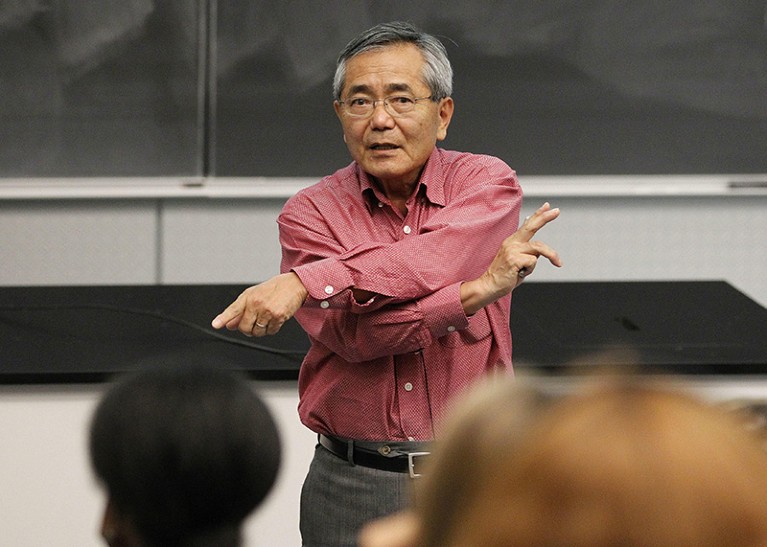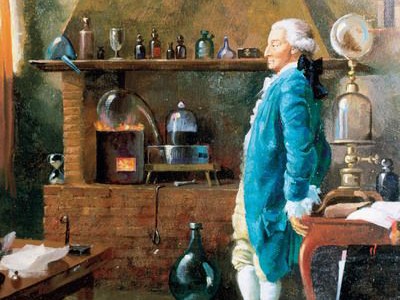
Credit: Brian Kersey/UPI/Alamy
Knitting carbon atoms together is fundamental to creating complex molecules for pharmaceuticals or industrial chemistry. In 2010, the architects of three of the most important reactions that make this possible, all using the rare metal palladium as a catalyst, were awarded the Nobel prize in chemistry. One was Japanese chemist Ei-ichi Negishi, whose cross-coupling is estimated to be used in at least one- quarter of all reactions in the pharmaceutical industry today. He has died, aged 85.
Carbon atoms are stable and difficult to react. Historically, organic chemists focused on making carbon more reactive, but this leads to unwanted by-products and is not effective for larger structures, such as drugs or plastics. Instead, in the 1970s, Negishi developed a reaction in which two intermediate molecules both bond to a metal catalyst, ultimately breaking away and forming a carbon–carbon bond with each other. The catalyst is then reused as the reaction repeats.
Negishi was born in 1935 in Hsinking (now Changchun), the capital of the Japanese puppet state of Manchukuo in northeast China. His father was a railway worker, and as a child he lived in Japanese-occupied Harbin, as well as Incheon and Seoul in South Korea, before moving to Japan at the end of the Second World War. There, he excelled as a student. He was admitted to the elite Shonan High School a year early, and at 17 gained admission to the University of Tokyo.
After graduation in 1958, he joined Teijin, a synthetic polymer company, but soon realized that his knowledge of organic chemistry wasn’t a match for that of his colleagues. Unable to afford further education in Japan, with the company’s support he did a Fulbright scholarship at the University of Pennsylvania in Philadelphia, where he was awarded his PhD in 1963. He returned to work at Teijin, but with his heart now set on a career in academia. Unable to find a position in Japan, he returned to the United States in 1966 as a postdoc at Purdue University in West Lafayette, Indiana, under Herbert Brown. He narrowly missed fellow Japanese organic chemist Akira Suzuki, who had left Brown’s group the year before, and with whom he was destined (along with Richard Heck of the University of Delaware in Newark) to share the Nobel prize.
Negishi thrived, despite the contrast between his calm, conflict-averse personality and that of the eccentric and argumentative Brown. He later described his mentor as a “true master of exploring chemistry”. After six years, he moved to Syracuse University, New York, where he focused on the problem of joining carbon molecules together efficiently. Since the mid-twentieth century, transition metals such as copper had been used as catalysts for these reactions, and by the late 1960s palladium had started to be used too. The problem was finding suitable carbon molecules that could be catalysed.
Between 1976 and 1978, Negishi and his collaborators published a series of papers detailing a new approach. This used an organic zinc compound and a palladium or nickel catalyst to bond with an organic halide (containing a halogen such as chlorine or iodine). As the two molecules bond with the palladium, the halogen and zinc are stripped away, allowing the two organic molecules to form a new carbon–carbon bond.
Negishi could now make a great variety of molecules in an easy way that was cost- and energy-efficient. The reaction also limited waste through reusing the palladium and by being more targeted than earlier coupling techniques, reducing the amount of side products. Negishi coupling remains one of the most widely used techniques for forming large organic compounds, with a long list of applications in the synthesis of natural products. Its uses range from the development of new antibiotics to the creation of antifungal agents for agriculture, and even to the building of light-emitting diodes in computer monitors.
In 1979, Negishi returned to Purdue, just in time to see Brown receive the Nobel prize in chemistry. He remained for the next 40 years. Here, Negishi was known for his approachable nature. His door always open, the laureate would press his students relentlessly to excel. He had a competitive streak — in the laboratory and at karaoke, for which he could sing more than 1,000 tunes. In addition to the Nobel prize, he received Japan’s Order of Culture in 2010. He retired from academic life only in 2019, aged 84.
Palladium-catalysed cross-coupling reactions revolutionized organic synthesis and reshaped an entire branch of science. However, recognizing the importance of his work, Negishi refused to patent his idea in the hope that it could be used widely. Throughout his career, Negishi emphasized the importance of work–life balance, believing there were four key ingredients to happiness: good health; happy surroundings, including family; pursuit of a worthy career; and at least one long-lasting hobby. Negishi’s was reading anything he could find, from the Bible (although he was not Christian) to ‘how to’ guides and poetry.



 Ronald Breslow (1931–2017)
Ronald Breslow (1931–2017)
 Gilbert Stork (1921–2017)
Gilbert Stork (1921–2017)
 Jack Baldwin (1938–2020)
Jack Baldwin (1938–2020)
 The chemistry chronicles
The chemistry chronicles








